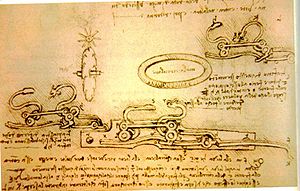Matchlock
- Matchlock
-
Platine à mèche
La platine à mèche est le premier type de mécanisme utilisé dans les armes à feu dans le but de faciliter leur usage. Elle a été inventée en Europe autour de 1400 et a été en usage, sur ce continent, jusqu'en 1720 lorsque la platine à silex la remplace complètement.
Historique
Au début des armes à feu à poudre noire, l’allumage de celle-ci se faisait en présentant avec la main, devant la cheminée à poudre, une mèche en étoupe allumée ou de l’amadou . Puis, au début du XVe siècle en France, ce fut l’invention de la platine à mèche qui contient tout le mécanisme de mise à feu, et principalement l’évolution technique du chien (arme).
La platine à mèche

Allumage automatique de Léonard de Vinci
A la platine est fixé une pièce en "S" appelée serpentin sur laquelle on fixe la mèche allumée. Un mécanisme permet au tireur de faire pivoter le serpentin de manière à mettre le feu au pulvérin (poudre fine) qui se trouve dans le bassinet. La lumière (canal entre le bassinet et la base canon) permet la transmission de la flamme à la poudre de propulsion. Pour décrasser la lumière, le tireur dispose d'une fine tige appelée aiguillette.
Léonard de Vinci étudia également la possibilité d’améliorer l’allumage des armes à feu. Le dessin[1] montre trois exemples de mécanismes pour ouvrir la gargousse et mettre simultanément le feu à la poudre. La mèche est allumée dans la bouche du « serpent », en appuyant sur la queue de détente elle s’abaisse en même temps que l’ouverture de la gargousse et met le feu à la poudre.
Références
Article connexe
 Portail de l’histoire militaire
Portail de l’histoire militaire
Wikimedia Foundation.
2010.
Contenu soumis à la licence CC-BY-SA. Source : Article Matchlock de Wikipédia en français (auteurs)
Regardez d'autres dictionnaires:
Matchlock — Match lock , n. An old form of gunlock containing a match for firing the priming; hence, a musket fired by means of a match. [1913 Webster] … The Collaborative International Dictionary of English
matchlock — 1690s, from MATCH (Cf. match) (n.1), in reference to the firing mechanism, + LOCK (Cf. lock) (n.1) in the firearm sense (1540s); probably so called for its resemblance to a door latching device … Etymology dictionary
matchlock — [mach′läk΄] n. 1. an old type of gunlock in which the charge of powder was ignited by a slow burning MATCH1 (sense 1) 2. a musket with such a gunlock … English World dictionary
Matchlock — Early German musket with serpentine lock The matchlock was the first mechanism, or lock invented to facilitate the firing of a hand held firearm. This design removed the need to lower by hand a lit match into the weapon s flash pan and made it… … Wikipedia
matchlock — /mach lok /, n. 1. an old form of gunlock in which the priming was ignited by a slow match. 2. a hand gun, usually a musket, with such a lock. [1630 40; MATCH1 + LOCK1] * * * Device for igniting gunpowder, invented in the 15th century. The first… … Universalium
matchlock — noun Date: circa 1637 1. a musket equipped with a matchlock 2. a slow burning match lowered over a hole in the breech of a musket to ignite the charge … New Collegiate Dictionary
matchlock — noun /ˈmatʃlɒk,ˈmætʃlɑk/ a) Early type of firearm, using a smoldering piece of cord to fire the powder in the firing pan. I crept silently up the hill road, but the fuse of my matchlock was wetted with the rain, and I could not slay Daoud Shah… … Wiktionary
matchlock — mætʃlÉ‘k / lÑ„k n. gunlock, mechanism which fires ammunition on a handgun or rifle … English contemporary dictionary
matchlock — noun an old fashioned type of gun with a lock in which a piece of wick was used for igniting the powder … English new terms dictionary
matchlock — match•lock [[t]ˈmætʃˌlɒk[/t]] n. 1) mil a gunlock that ignites the charge by a slow match 2) mil a gun, usu. a musket, with such a lock • Etymology: 1630–40 … From formal English to slang


